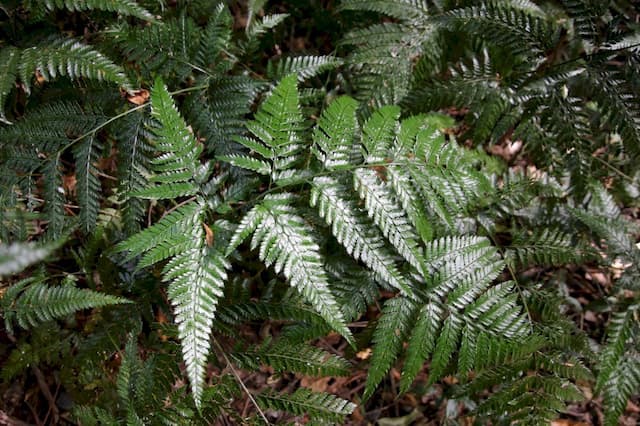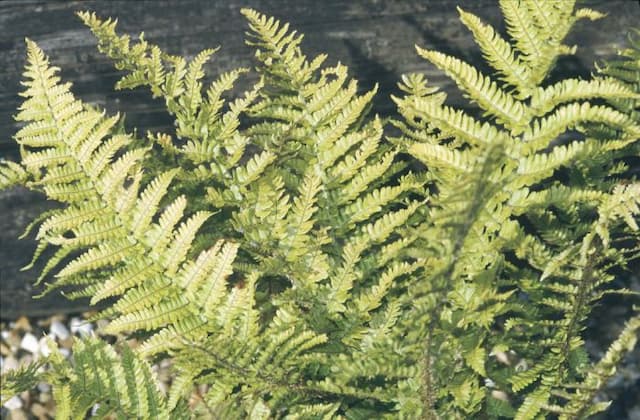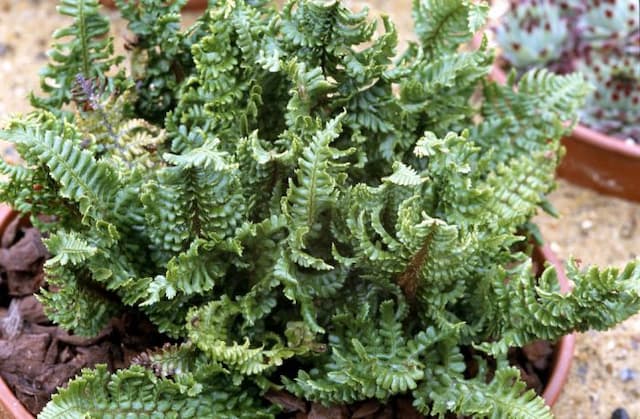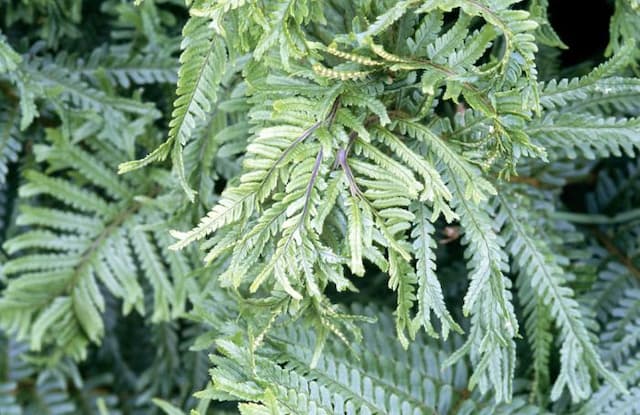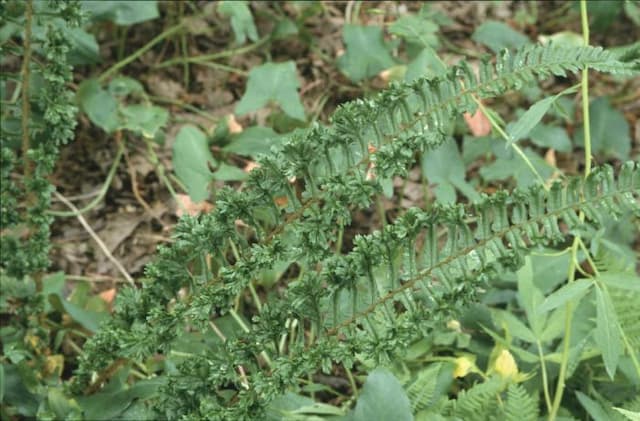Soft Shield Fern Polystichum setiferum











ABOUT
The plant commonly known as the soft shield fern is a visually striking perennial that captures the essence of a lush, deep green forest. Its fronds, which have a soft and fluffy feel, contribute to its common name. These fronds are divided into numerous smaller leaflets that give the fern a dense, feathery appearance. The leaflets are arranged in an alternate fashion along a central stem, each leaflet being somewhat triangular or lance-shaped with a finely serrated edge that creates a delicate and intricate texture. The young fronds unfurl from a central crown, appearing initially coiled like a scroll, a feature that plant enthusiasts often find particularly attractive. This early stage of the frond, called a fiddlehead or crozier, has a soft, downy coating that adds to the plant's overall allure. As they mature, the fronds open out into a shuttlecock formation that is lush and graceful. The surface of the fronds exhibits a vibrant, deep green hue that effectively captures and plays with light, giving the plant a lively and radiant quality among the shade of a garden. The soft shield fern’s graceful form, combined with its lush coloration, makes it an ideal choice for adding texture and greenery to shaded areas or woodland gardens, often lending these spaces an enchanting, storybook feel.
About this plant
 Names
NamesFamily
Dryopteridaceae
Synonyms
Soft Shield Fern, Alaska Fern
Common names
Aspidium setiferum, Polystichum aculeatum var. setiferum, Polystichum lobatum, Polystichum setiferum var. plumosum, Polystichum setiferum var. setiferum, Polystichum setiferum var. lobatum, Polystichum setiferum var. congestum, Polystichum setiferum var. cambricum, Polystichum setiferum var. abbreviatum, Polystichum setiferum var. polydactylum.
 Toxicity
ToxicityTo humans
Soft shield fern (Polystichum setiferum) is not known to be toxic to humans. Ingesting this plant is not typically associated with any poisoning symptoms or adverse health consequences for people under normal circumstances.
To pets
Soft shield fern (Polystichum setiferum) is also not known to be toxic to pets. It's not associated with any specific symptoms of poisoning or adverse health effects if pets ingest parts of the plant. However, individual animals might have varying sensitivities or allergic reactions, so it's always prudent to monitor pets and keep any houseplants out of their reach whenever possible.
 Characteristics
CharacteristicsLife cycle
Perennials
Foliage type
Evergreen
Color of leaves
Green
Height
1-4 feet (30-120 cm)
Spread
2-3 feet (60-90 cm)
Plant type
Fern
Hardiness zones
8-9
Native area
Europe
Benefits
 General Benefits
General Benefits- Aesthetic Appeal: Polystichum setiferum, commonly known as Soft Shield Fern, adds beauty to gardens with its lacy, finely divided fronds and elegant, arching growth habit.
- Shade Tolerant: It flourishes in shady areas where other plants might struggle, making it suitable for woodland gardens and shaded borders.
- Low Maintenance: Once established, this fern requires minimal care, making it a convenient choice for both novice and experienced gardeners.
- Drought Resistance: It is relatively drought-tolerant compared to other ferns, although it prefers moist conditions.
- Hardiness: Soft Shield Fern is winter hardy and can survive in colder climates, making it a versatile plant for various garden zones.
- Deer and Rabbit Resistance: This fern is generally resistant to grazing by deer and rabbits, which can help preserve the integrity of a garden.
- Soil Improvement: It can contribute to soil health by adding organic matter as its fronds die back and decompose.
- Garden Design: Its texture and form offer contrast when planted alongside plants with broader leaves or different growth habits.
- Evergreen: In many climates, Polystichum setiferum remains evergreen, providing year-round interest and coverage.
 Medical Properties
Medical PropertiesThis plant is not used for medical purposes.
 Air-purifying Qualities
Air-purifying QualitiesThis plant is not specifically known for air purifying qualities.
 Other Uses
Other Uses- Soil Erosion Control: Polystichum setiferum, commonly known as Soft shield fern, is effective at stabilizing soil on slopes and preventing erosion due to its dense root system.
- Fairy Gardens: Due to its delicate and intricate foliage, Soft shield fern is an ideal plant to include in fairy gardens to provide a whimsical look.
- Floral Arrangements: The fronds of Soft shield fern can be used in cut flower arrangements to add greenery and texture.
- Shade Gardens: This fern is a wonderful addition to shade gardens, providing lush, green ground cover where other plants might struggle.
- Backdrop Planting: Gardeners often use Soft shield fern as a backdrop plant to create a contrast for flowering plants in borders and beds.
- Winter Garden Interest: With evergreen fronds, Soft shield fern provides color and interest in the garden even during winter months.
- Container Gardening: Soft shield fern can thrive in a container environment, allowing those with limited space to enjoy its beauty.
- Living Mulch: The dense growth habit of Soft shield fern can act as living mulch, helping to retain soil moisture and suppress weed growth.
- Education: Educators can use Soft shield fern to teach students about plant lifecycle and reproduction, particularly fern propagation and spore dispersal.
- Crafts: Dried fronds of Soft shield fern can be used in crafts, such as making bookmarks, framed botanical art, or part of wreaths and other decoration items.
Interesting Facts
 Feng Shui
Feng ShuiThe Soft Shield Fern is not used in Feng Shui practice.
 Zodiac Sign Compitability
Zodiac Sign CompitabilityThe Soft Shield Fern is not used in astrology practice.
 Plant Symbolism
Plant Symbolism- Perseverance: Polystichum setiferum, commonly known as Soft Shield Fern, grows in tough conditions and is evergreen, symbolizing the ability to endure and maintain integrity despite harsh circumstances.
- Ancient wisdom: As ferns are among the oldest groups of plants, they often symbolize ancient knowledge and the continuity of time.
- Shelter: The dense, lush fronds of the Soft Shield Fern can provide cover in a garden, symbolizing protection and a safe haven.
- Confidence: The upright growth and robust nature of the fern can symbolize confidence and the strength to stand tall.
- Rebirth and new beginnings: Ferns, with their intricate frond patterns that unfurl as they grow, represent new life and the unfolding of mysteries.
 Water
WaterSoft Shield Ferns prefer evenly moist soil, so it's crucial to water them thoroughly whenever the top inch of soil feels dry to the touch. This could mean watering approximately every 7 to 10 days, but this frequency may vary depending on environmental conditions. It's important to avoid overwatering, as standing water can lead to root rot. When watering, use enough water to soak the soil all the way through; for a potted fern, this might be around 16 to 32 ounces every week, depending on the size of the pot and the indoor conditions.
 Light
LightThe Soft Shield Fern thrives best in partial to full shade, making it an ideal plant for a north-facing garden or a spot under the canopy of larger trees. It should be placed where it receives dappled sunlight or only indirect light as exposure to direct sunlight can scorch its fronds.
 Temperature
TemperatureSoft Shield Ferns are hardy and can withstand a wide range of temperatures, performing best between 65°F to 75°F. They're able to survive short periods of cold down to about 50°F, but shouldn't be exposed to temperatures below that. They also prefer not being in environments that are consistently above 80°F.
 Pruning
PruningPruning Soft Shield Ferns is generally done to remove dead or damaged fronds and to maintain a tidy appearance. Pruning can be done as needed throughout the growing season, ideally in the spring to clear out any winter damage. It's not necessary to prune frequently—once a year is often sufficient.
 Cleaning
CleaningAs needed
 Soil
SoilSoft shield fern thrives in a well-draining, humus-rich soil mix that retains moisture. Aim for a slightly acidic to neutral pH range, around 5.5 to 7.0. An ideal soil mix might consist of one part garden soil, one part peat moss or leaf mold, and one part perlite or coarse sand to ensure proper drainage.
 Repotting
RepottingSoft shield ferns generally require repotting every 2 to 3 years to prevent crowding and refresh the soil. It is best done in spring before the growing season begins, ensuring the fern has room to grow and adequate nutrients.
 Humidity & Misting
Humidity & MistingSoft shield ferns (Polystichum setiferum) prefer high humidity levels, ideal conditions would be between 60% to 70%. They thrive when the air around them is moist, mimicking their natural woodland habitat.
 Suitable locations
Suitable locationsIndoor
Place soft shield fern in bright, indirect light and ensure high humidity.
Outdoor
Plant soft shield fern in shaded, moist, and well-draining areas.
Hardiness zone
5-8 USDA
 Life cycle
Life cyclePolystichum setiferum, commonly known as Soft Shield Fern, begins its life cycle as a spore which germinates to produce a small, heart-shaped gametophyte (prothallus). This gametophyte develops sex organs and, upon fertilization, gives rise to a new sporophyte—the familiar fern plant. The young fern, or sporophyte, starts as a fiddlehead which unfurls into fronds as it matures. These fronds are pinnately divided, giving the plant its characteristic feathery appearance. As the fern grows, it forms a rhizome from which new fronds emerge seasonally. When mature, the fronds produce clusters of sporangia, usually on the underside of the fronds, which will eventually release spores to begin the cycle anew.
 Propogation
PropogationPropogation time
Spring to Summer
The most popular method of propagation for the Polystichum setiferum, commonly known as the Soft Shield Fern, is by dividing the rhizomes. This is typically done in the spring when the plant has just begun to grow. Carefully dig up the fern, making sure to get a generous amount of roots. Using a sharp knife, cut the rhizome into sections, each with at least one frond and a portion of the root system. Replant the divisions immediately at the same depth they were previously growing and water them well to help establish the roots. It is important to ensure that the newly planted divisions are kept moist, but not waterlogged, to promote healthy growth.
